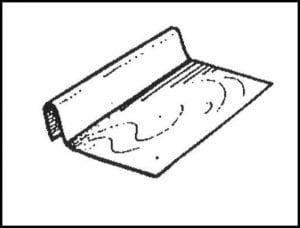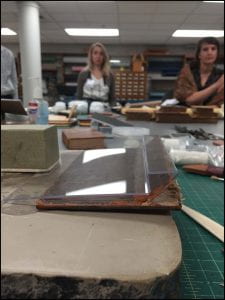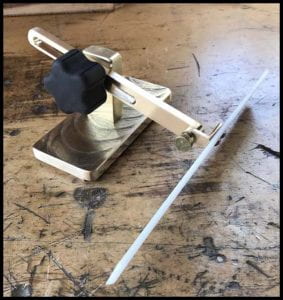I was fortunate to attend the Conservation of Leather Bookbindings workshop sponsored by AIC/FAIC (the American Institute for Conservation and the Foundation for Advancement in Conservation Endowment for Professional Development) in March, 2020, just before COVID-19 changed everything. The workshop was led by Jeff Peachey, an independent book conservator and toolmaker, who was a generous instructor, meeting every student at our own level, guiding us toward a more thorough understanding of why to pursue certain treatments and how to carry them out. Liz Dube, Head of Analog and Preservation Services at the Hesburgh Libraries, University of Notre Dame, hosted us in the conservation lab in the Reyniers Building. Special thanks are due to Liz and Jennifer Hunt Johnson, Special Collections Conservator, Maren Rozumalski, The Gladys Brooks Conservation Fellow, Neil Chase, Preventative Conservation Specialist, and Tosha McComb, General Collections Conservation Technician. They were welcoming, friendly, and helpful.
The nine participants came from seven institutions: University of Chicago, Indiana University, Hagley Museum and Library, Cornell University, Public Library of Cincinnati and Hamilton County and the University of Cincinnati, Johns Hopkins University, and University of Notre Dame. With Jeff, we investigated several methods of reattaching the boards of leather bound books. A detached board or a weak attachment at the hinge of the board and the bookblock is a common problem that conservators often encounter in special collections materials.
We explored many treatment options: sewing extensions, joint tacketing, hinge repairs, board slitting, and leather rebacking. Jeff asked us to bring several practice books that we could experiment on. I found good candidates at local used book shops: some with hollow backs, some with tight backs, all with laced-on boards. In advance of the workshop, I emailed him photographs and condition reports; he wrote back with treatment possibilities. At the workshop, Jeff led discussions and demonstrated techniques for the class. He asked us to develop treatment proposals for our books which he discussed with us individually. And we had plenty of time to try out what we were learning at our benches, all the while consulting with each other and asking Jeff questions. One of the most valuable parts of the workshop was producing a list of pros and cons for all of the treatments we talked about and practiced. We drew on everyone’s experiences to produce nuanced lists of reasons to pursue a certain treatment or to try something more appropriate. I’ll refer to these often in the future. I’ve created a lab resource to share with our conservation staff, along with my workshop notes and photographs, Jeff’s handouts and bibliography, and some newly purchased tools and supplies.
At the top of this page of the class flipchart, Peachey quoted the motto of the Elkhart Institute of Science and the Arts, the predecessor of Goshen College, his alma mater: “Practical knowledge is the great power that rules the world.” This was a theme of the workshop – refining our hand skills using the tools of the trade.
Jeff Peachey develops and produces many bookbinding specific tools that address the idiosyncratic needs of a conservator at the bench. I use his carbon lifter to gently free cloth from boards and one of his paring knives to reduce the thickness of leather when rebacking books.
Conservators working on their own often improvise innovative solutions to common problems we all face. One of these problems is propping up a lifted layer of leather or cloth while working on a book, getting ready to slide a reinforcing layer of cloth, paper, or leather under the original board covering. The lifted layer is very thin and fragile, and yet it must be secured out of the way while adhesives are applied to the board underneath it.
Don Etherington, founder of the Etherington Conservation Center, uses what he refers to as a “handy gadget” in his article Repairing an Original Cloth Case Binding that he distributed at the Brodsky Lecture and Workshop held at Syracuse University in 2009, although he was using the metal gadget long before then.
Some workshop participants had their own solutions to this problem. Jennifer Jarvis and her colleague Alessandro Scola from the Milton S. Eisenhower Library at Johns Hopkins University developed a prop made of Vivak (a transparent thermoplastic sheet that is easily bent on a metal brake) to serve this purpose.
Another participant, Melina Avery from the University of Chicago Library, drew a diagram of her solution on our flipchart. She uses heavy duty aluminum foil, string, and a weight.
Elise Calvi, from Indiana University Libraries came up with another idea using folded clear polyester film and a weight.
By the following week, Jeff Peachey himself had devised another solution to address the problem using brass and Delrin (a thermoplastic polymer) that he calls the rebacking jig.
I appreciate the ingenuity that resulted in the creation of all of these solutions! The first one I’ll try is the folded clear polyester film because I have that on hand in the lab.
I am grateful to Jeff Peachey, to the staff who work at the Conservation Lab at the University of Notre Dame, and to all of the participants for a wonderful workshop. I look forward to reading the following articles that were referenced in Jeff’s bibliography:
Brockman, James. “Rebacking – An alternative Approach,” The New Bookbinder. Journal Of Designer Bookbinders, Vol. 11, 1991: 36-46.
Espinosa, Robert. “Joint Tacketing: A Method of Board Reattachment,” Book and Paper Group Annual, v. 10, 1991.
I’m interested in learning more about these approaches to reattaching boards and to compare them to some of the methods I experimented with at the workshop. I look forward to trying some new techniques and tools and to sharing this knowledge with our staff when post-COVID lab workflows begin.








